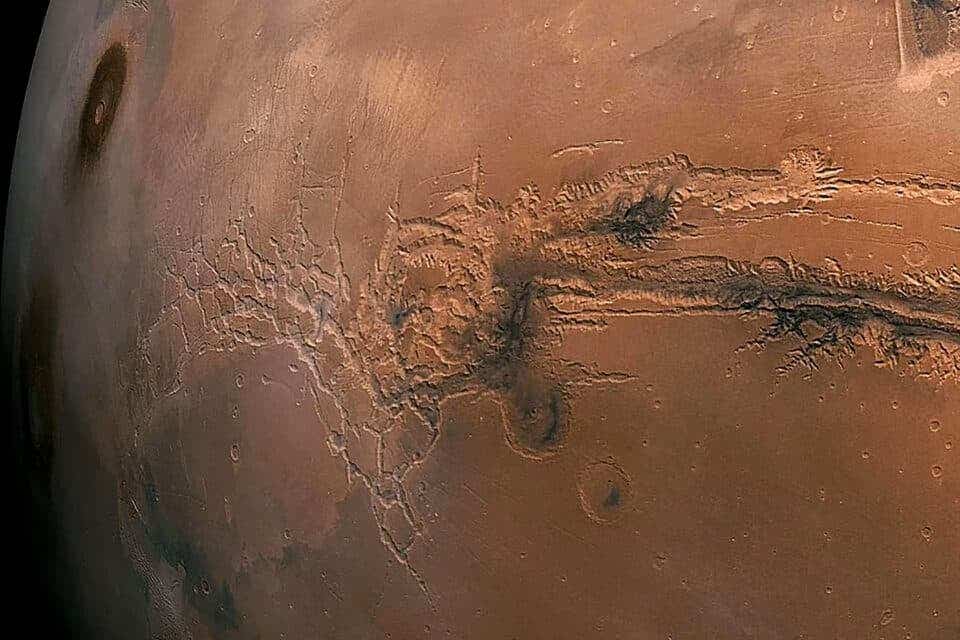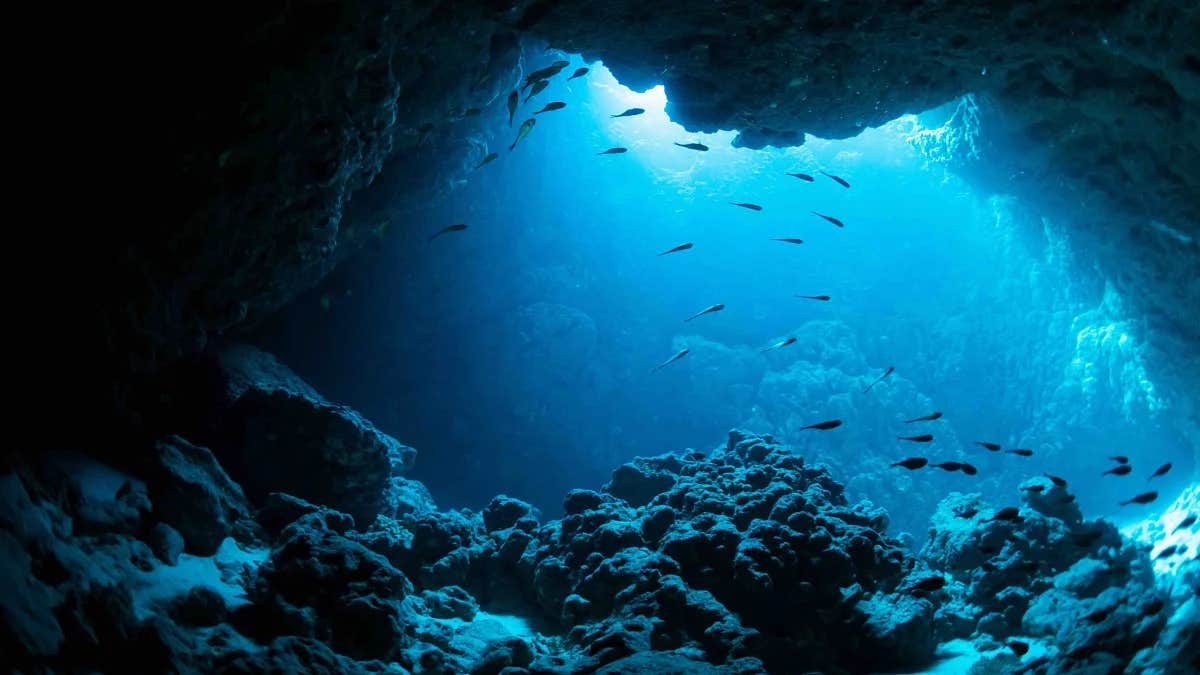Astronomers discover giant volcano and glacier on Mars
Researchers revealed a massive volcano and a potential sheet of glacier ice in the eastern region of Mars’ Tharsis volcanic province.

Researchers revealed the presence of a massive volcano and a potential sheet of glacier ice in the eastern region of Mars' Tharsis volcanic province. (CREDIT: NASA)
A significant announcement made at the 55th Lunar and Planetary Science Conference revealed the presence of a massive volcano and a potential sheet of glacier ice in the eastern region of Mars' Tharsis volcanic province, near the equator.
Despite being observed by spacecraft orbiting Mars since Mariner 9 in 1971, the volcano remained largely unnoticed due to extensive erosion, nestled between the intricate Noctis Labyrinthus and the grand Valles Marineris.
Named provisionally as "Noctis volcano," this colossal structure sits at coordinates 7° 35' S, 93° 55' W, soaring to an elevation of +9022 meters (29,600 feet) and spanning 450 kilometers (280 miles) in width. Its immense size and complex history suggest prolonged volcanic activity.
A giant volcano hiding in plain sight in one of Mars’ most iconic regions. (CREDIT: NASA/USGS Mars globe)
Interestingly, a recent volcanic deposit in its southeastern region hints at the presence of buried glacier ice, marking a significant discovery for future Mars exploration endeavors.
Dr. Pascal Lee, a planetary scientist at the SETI Institute and the Mars Institute, leading the study, remarked, "We were examining the geology of an area where we had found the remains of a glacier last year when we realized we were inside a huge and deeply eroded volcano."
Several geological features confirm the volcanic nature of the area. Elevated mesas form an arc around the central summit, sloping outward, while lava flows, pyroclastic deposits, and hydrated mineral occurrences further indicate its volcanic origin.
Related Stories
Sourabh Shubham, a graduate student at the University of Maryland and co-author of the study, highlighted, "This large volcano is a long-sought 'smoking gun' in understanding Mars' geological history."
Additionally, the study reports the discovery of a vast area of volcanic deposits within the volcano's perimeter, characterized by low, rounded mounds known as "rootless cones," suggesting explosive steam venting or steam swelling phenomena.
Last year, the research team identified remnants of a glacier within the volcanic region, hinting at a rich history of glacial activity. The presence of sulfate deposits, similar to those found in the breached rootless cones, strengthens the hypothesis of a buried sheet of glacier ice beneath the volcanic blanket.
Topographic map showing the iconic location of the Noctis volcano between the largest volcanic and canyon provinces on Mars. (CREDIT: NASA Mars Global Surveyor (MGS) Mars Orbiter Laser Altimeter (MOLA) digital elevation model.)
The Noctis volcano has undergone extensive modification over time, possibly due to fracturing, thermal erosion, and glacial activity. The volcano, resembling a shield with layered accumulations of pyroclastic materials, lavas, and ice, has experienced repeated glaciations and volcanic eruptions, shaping its current landscape.
Despite its mysteries, the Noctis volcano presents an enticing opportunity for scientific exploration. Its ancient history, coupled with the potential for past and present volcanic activity, raises questions about Mars' evolution and the possibility of life. Moreover, the proximity of glacier ice near the equator offers promising prospects for future robotic and human missions, providing a potential source of water and rocket fuel.
Topographic map of the Noctis volcano. The Noctis volcano does not present the conventional cone shape of a typical volcano because a long history of deep fracturing and erosion has modified it. (CREDIT: NASA Mars Reconnaissance Orbiter (MRO) Context Camera (CTX) mosaic and Mars Global Surveyor (MGS) Mars Orbiter Laser Altimeter (MOLA) digital elevation model. Geologic interpretation & annotations by Pascal Lee & Sourabh Shubham 2024)
Dr. Pascal Lee emphasized, "It's really a combination of things that makes the Noctis volcano site exceptionally exciting...the place is looking very attractive for robotic and human exploration."
The study utilized data from various NASA and ESA missions, including Mariner 9, Viking Orbiter 1 and 2, Mars Global Surveyor, Mars Odyssey, Mars Reconnaissance Orbiter, and Mars Express, along with tools like NASA's Planetary Data System and online visualization platforms.
Detailed analysis of the altimetry of the region using NASA’s Mars Global Surveyor (MGS) Mars Orbiter Laser Altimeter (MOLA) data, in combination with high resolution imaging data from NASA’s Mars Reconnaissance Orbiter (MRO) High Resolution Imaging Science Experiment (HiRISE) and Context Imager (CTX), and from the European Space Agency’s Mars Express (MEX) High Resolution Stereo Camera (HRSC) enabled the discovery of the Noctis volcano. (CREDIT: Mars Express HRSC color mosaic / ESA/DLR/FU Berlin CC BY-SA 3.0 IGO)
The discovery of the Noctis volcano opens new avenues for understanding Mars' geological history, searching for signs of life, and planning future exploration missions, marking a significant milestone in our exploration of the Red Planet.
About the SETI Institute
Founded in 1984, the SETI Institute is a non-profit, multidisciplinary research and education organization whose mission is to lead humanity’s quest to understand the origins and prevalence of life and intelligence in the universe and share that knowledge with the world. Research at the SETI Institute encompasses the physical and biological sciences and leverages expertise in data analytics, machine learning and advanced signal detection technologies. The SETI Institute is a distinguished research partner for industry, academia and government agencies, including NASA and NSF.
For more science stories check out our New Discoveries section at The Brighter Side of News.
Note: Materials provided above by the The Brighter Side of News. Content may be edited for style and length.
Like these kind of feel good stories? Get the Brighter Side of News' newsletter.



